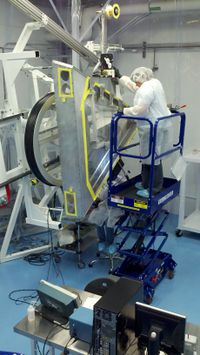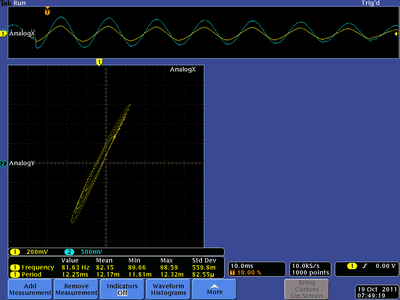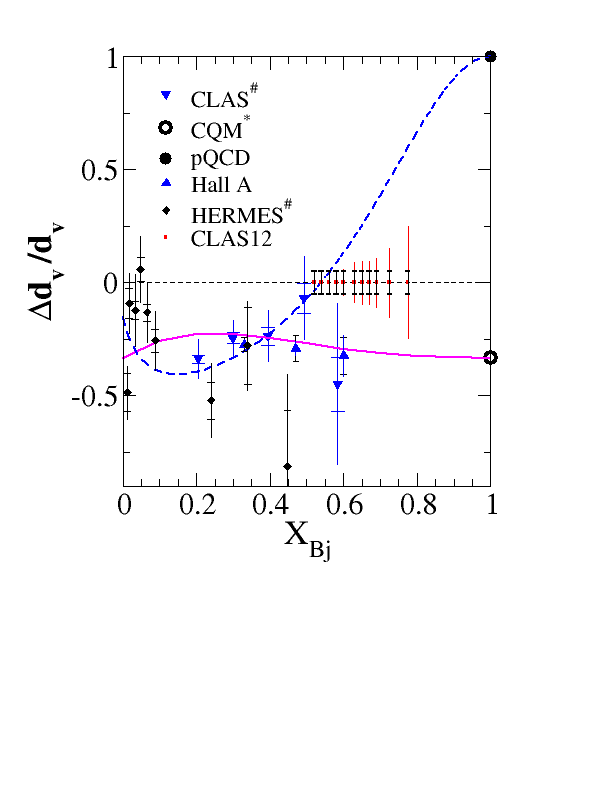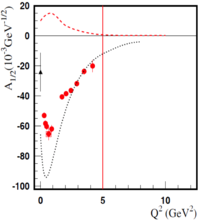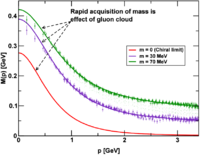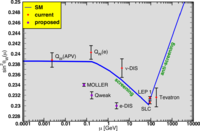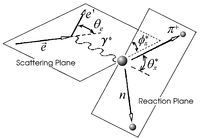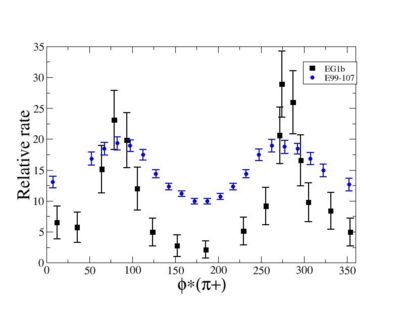Difference between revisions of "2011 NSF Proposal"
| (2 intermediate revisions by one other user not shown) | |||
| Line 1: | Line 1: | ||
=Public statement= | =Public statement= | ||
| − | This NSF award supports our continuing research program at Jefferson Lab using electromagnetic probes to study hadronic matter at the fundamental level. Our group focuses on four experimental efforts that test the basic nature of particle interactions at the quark gluon level | + | This NSF award supports our continuing research program at Jefferson Lab using electromagnetic probes to study hadronic matter at the fundamental level. Our group focuses on four experimental efforts that test the basic nature of particle interactions at the quark gluon level. One of our experiments extracts polarization observables from meson photoproduction with linearly-polarized photons on the proton and deuteron and will result in two ISU PhD theses during this funding period. Another experiment will investigate quark distributions at extreme kinematics where the quarks carry most of the nucleon's momentum. Five particle tracking drift chambers are currently being constructed at ISU to be used by the above epxeriments and Jefferson Lab's Hall B 12 GeV program. A high-precision measurement of the pion lifetime is being undertaken in Jefferson Lab's Hall B. This experimental effort seeks to probe the mechanism through which a neutral charged pion can decay into two photons to stringently test confinement-scale quantum chromodynamics. Another high-precision experiment in Hall A, MOLLER, uses the parity-violating property of the weak interaction to measure a fundamental parameter of the Standard Model known as the Weinberg (or mixing) angle to within a relative uncertainty of 0.1%. When combined with other experiments, this measurement will place strong constraints on proposed extensions to our present version of the Standard Model. These research programs at JLab, the accelerator facilities at ISU, and continuous detector construction projects in the group's Laboratory for Detector Science, combine in an active program to provide a breadth of experiences for four graduate students and to train the next generation of scientists. |
---------- | ---------- | ||
Latest revision as of 00:13, 14 May 2012
Public statement
This NSF award supports our continuing research program at Jefferson Lab using electromagnetic probes to study hadronic matter at the fundamental level. Our group focuses on four experimental efforts that test the basic nature of particle interactions at the quark gluon level. One of our experiments extracts polarization observables from meson photoproduction with linearly-polarized photons on the proton and deuteron and will result in two ISU PhD theses during this funding period. Another experiment will investigate quark distributions at extreme kinematics where the quarks carry most of the nucleon's momentum. Five particle tracking drift chambers are currently being constructed at ISU to be used by the above epxeriments and Jefferson Lab's Hall B 12 GeV program. A high-precision measurement of the pion lifetime is being undertaken in Jefferson Lab's Hall B. This experimental effort seeks to probe the mechanism through which a neutral charged pion can decay into two photons to stringently test confinement-scale quantum chromodynamics. Another high-precision experiment in Hall A, MOLLER, uses the parity-violating property of the weak interaction to measure a fundamental parameter of the Standard Model known as the Weinberg (or mixing) angle to within a relative uncertainty of 0.1%. When combined with other experiments, this measurement will place strong constraints on proposed extensions to our present version of the Standard Model. These research programs at JLab, the accelerator facilities at ISU, and continuous detector construction projects in the group's Laboratory for Detector Science, combine in an active program to provide a breadth of experiences for four graduate students and to train the next generation of scientists.
This proposal requests support to continue a program using electromagnetic probes to study hadronic matter on a fundamental level at the Thomas Jefferson National Accelerator Facility. The Nuclear Physics group at Idaho State University has added a new faculty member since the last proposal three years ago. The group has also begun constructing five drift chambers for Jefferson Lab's Hall B upgrade. We are requesting support from the NSF to allow our graduate students to complete their Ph.D. degrees under our current physics program and facilitate the construction of the above equipment for the 12 GeV JLab upgrade.
Project Summary
Intellectual Merit
\begin{center} {\it \underline {The Intellectual Merit of the Proposed Activities}} \end{center}
The intermediate energy nuclear physics group at Idaho State University (ISU) has an established fundamental physics program based at Jefferson Lab. ISU group members Dr.~Dustin McNulty and Dr.~Tony Forest are currently managing the construction and testing of the CLAS12 Region I drift chambers at ISU for Jefferson Lab's 12 GeV upgrade. The group's physics program includes nucleon spin structure and resonance studies, analysis of vector meson and hyperon photoproduction, a precision measurement of the $\pi^0$ lifetime, and precision measurements of parity violating electron scattering. Dr.~Tony Forest and Dr.~Philip Cole are co-spokespersons on approved 12~GeV Hall~B experiments PR12-06-109 and PR12-09-003, respectively. Dr.~Cole and three graduate students are presently focused on comprehensive measurements of vector meson and hyperon photoproduction employing linearly polarized photons to improve our understanding of the underlying symmetry of the quark degrees of freedom in the nucleon, the nature of the parity exchange between the incident photon and the target nucleon, and the mechanism of associated strangeness production in electromagnetic reactions. Dr.~Dan Dale is a spokesperson of the PrimEx Collaboration which is performing a high precision measurement of the $\pi^0$ lifetime as a test of the QCD chiral anomaly plus corrections. This measurement uses photoproduction in the Coulomb field of a nucleus to facilitate a stringent test of the fundamental predictions of quantum chromodynamics in the confinement scale regime. Dr.~Dustin McNulty and Dr.~Tony Forest are collaborators in parity violation experiments PR12-09-005 and E05-008, respectively, with a focus on measuring the low energy constant $d_{\Delta}$ by means of using inelastic parity violation.
Broader Impacts
\begin{center} {\it \underline {Broader Impacts of the Proposed Activities}} \end{center}
In addition to the scientific program described here, this proposal represents a major effort in the area of educating future scientists. The present shortage of graduate students in experimental and theoretical nuclear physics is having a detrimental impact on our national laboratories and facilities which posses a plethora of data but limited manpower for analyzing and disseminating the information. The Idaho State University Department of Physics is comprised of nine tenure-track faculty, all of whom have research interests which are in some way connected to nuclear physics and are in a position to directly address the shortage of graduate students. With its on campus accelerator and detector laboratories, the Department focuses on experimental and applied physics, giving students a strong hands-on educational experience. ISU's physics program is relatively new and rapidly growing. Last year, ISU physics faculty brought in approximately \$8 million in external research funds. Its Ph.D.~program, established in the Fall of 2005, presently has approximately 30 students with an additional 15 students pursuing research at the M.S.~level.
The PIs are further strengthening the ISU graduate program by recruiting high-caliber students from Latin America. Latin America remains an underutilized intellectual resource. The ISU Group has strong ties to Colombia and has attracted four talented graduate students into nuclear physics at ISU; three are working on JLab-related projects and one graduated in late 2009 and is now an Assistant Professor in Bogot\'{a}, Colombia. The activities delineated within this proposal will provide another avenue through which the program can continue to solidify this mutually beneficial bridge of collaboration among countries in the Americas.
Project Description
File:2011projectDescription.pdf
A Program to Study Hadronic Matter using Electromagnetic Probes at JLab
We are requesting continuing NSF support for our established program studying hadronic matter using electromagnetic probes. This program currently supports four graduate students, three of whom are in mid stride towards completing their Ph.D.s~in experimental nuclear physics. Even though the group was recently formed at Idaho State University (ISU), each of the senior-level participants have an established history of intense involvement in the Jefferson Lab (JLab) physics program from their research at their former universities. The PIs, moreover, have a strong record of constructing scientific instrumentation with NSF funding and each has made substantial impacts to the field. The significance of our research and the objectives for the proposed work period are described in section~\ref{section:IntelectMerits}. Through our well established partnership with several universities in the Americas, we discuss in section~\ref{section:BroaderImpacts} our continued recruitment of underrepresented groups in physics. The requested funding will not only enable our graduate students to complete their JLab data analysis in a timely manner and obtain their Ph.D.~degrees, but these monies will further provide the necessary support to enable ISU to construct five of the six inner Region I (R1) drift chambers for the 12~GeV upgrade to Hall B of JLab; these tracking chambers being a critical-path item for the upgrade.
Intellectual Merit of the Proposed Activity
The ISU Physics Program
Jefferson Lab 12 GeV program
The physics Ph.D.~students at ISU are currently analyzing data, taken by the CLAS collaboration, to elucidate the structure of a nucleon using polarization observables. The extraction of photonuclear asymmetries and measurements of a nucleon's polarized quark distribution functions have been the group's two central objectives. The next step in the pursuit of these objectives will require the use of a 12-GeV energy upgrade to CEBAF. The ISU group has become responsible for the construction of five drift chambers for the Hall-B detector upgrade (CLAS12) as a means to achieve the above objectives and as a service to the intermediate energy nuclear physics community.
CLAS12 Region I Drift Chamber Construction
The ISU group has been contracted by Jefferson Science Associates to construct five drift chambers for the 12 GeV upgrade to Hall~B. Two members of the group, Dr.~Dustin McNulty and Dr.~Tony Forest, constructed a Class-10,000 clean room this past summer for the project. The first chamber is currently being strung with wires, as shown in the figure below, and is expected to be completed by January 2011. Each chamber takes approximately 25~weeks to construct. A team of stringers and a lead stringer have been hired for this task with the ISU group taking the role of management and quality control. We expect to complete the last chamber before October, 2013.
Although Jefferson Lab has provided adequate support for the construction of the chambers, the ISU group has made a commitment to support the quality assessment and testing of the drift chambers. Tension measurements and continuity tests are the first steps of quality assurance that are done during the drift chamber construction phase. The Figure below illustrates a measurement of the drift chamber wire tension after stringing to ensure that it meets specifications. The next steps are to monitor the initial current draw of a powered chamber and measure sense wire signals resulting from cosmic ray induced ionization events in the drift chamber. The ISU group will oversee these quality controls and tests before the chambers are shipped to JLab for installation.
\singlespace \begin{figure} [!hbp] \begin{center} { \scalebox{0.5} [0.5]{\includegraphics[height=6in]{figs/10242011_Pic1.eps}} \scalebox{0.5} [0.5]{\includegraphics[height=6in]{figs/10182011_Tension_SS.eps}} } \caption{The left figure shows a photograph of two technicians constructing one of the R1 drift chambers in the ISU physics clean room. The right figure is an illustration of a wire tension measurement made by comparing the phase of a current induced in a drift chamber wire by a small external magnetic field (Analog $X$) to a driving force generated by a sinusoidal current (Analog $Y$). The driving force is applied for several periods of the drive frequency and then compared to the response observed during an equal time interval~\cite{RothNIM}.} \label{delqJLab} \end{center} \end{figure} \doublespace
The CLAS12 Polarized Structure Function Program
\paragraph{The CLAS12 Polarized Structure Function Program}
Spin structure functions of the nucleon have been measured in deep inelastic lepton scattering (DIS) for nearly 30 years since the first experiments at SLAC. Interest increased substantially in the 80s when the EMC collaboration reported that the quark helicities only made a small contribution to the overall helicity of the proton, according to their data. This ``spin crisis" led to a vigorous theoretical and experimental effort over the next 20 years, with a large data set collected at CERN, SLAC, DESY, and JLab.
Interest in the quark contributions to a nucleon's structure continues unabated. At large Bjorken $X$, new data from JLab address for the first time the question of the helicity structure of the nucleon in a kinematic realm where sea quark and gluon contributions are minimal thereby making one mostly sensitive to valence quarks. An example of these results is shown in Fig.~\ref{deltadJLab}. To extend this region to higher $x$ and moderate $Q^2$, one needs higher beam energies than presently available at JLab. In particular, to test various models of the asymptotic value of the virtual photon asymmetry $A_1(x)$ as $x \rightarrow 1$, one needs the upgraded CEBAF with 12~GeV beam energy.
\singlespace
\begin{figure} [t]
\begin{center}
{
\scalebox{0.4} [0.5]{\includegraphics[height=5in]{figs/DeltaDoverD_CLAS12.eps}}
}
\caption{The expected statistical uncertainty of a $\Delta d/d$ measurement from CLAS12. The dashed line represents a pQCD prediction while the solid line represents the prediction from a hyperfine perturbed constituent quark model. The solid triangles are measurements from X.~Zheng {\it et al.}~\cite{Zhang}, and the diamonds are from A.~Airapetian {\it et al.}~\cite{AirapetianHERMES}. The squares represent a prediction of the precision obtained by a SIDIS measurement performed using the energy upgraded CEBAF and the upgraded CLAS. The risers represent systematic uncertainty and the error bar lines are statistical uncertainties.}
\label{deltadJLab}
\end{center}
\end{figure}
\doublespace
The comprehensive data set to be collected by experiment PR12-06-109 will contribute substantially to our knowledge of polarized parton distribution functions for all quark flavors and even the polarized gluon distribution $\Delta g$. Through Next-to-Leading Order (NLO) analysis of the world data on inclusive DIS (using the DGLAP evolution equations), one can constrain these distribution functions and their integrals. Existing CLAS data from 6 GeV have already made an impact on these fits. The expected data from the proposed experiment at 11~GeV will yield further dramatic reductions in the errors on these distributions. Semi-inclusive DIS (SIDIS) data will also be collected, where, in addition to the scattered electron, we will also detect some of the leading hadrons produced after the struck quark hadronizes. These data will further constrain the NLO fits and improve the separation of the various quark flavors' contribution to nucleon observables.
N*s at 12 GeV
For the foreseeable future, the CLAS12 detector will be the sole facility worldwide capable of delivering comprehensive information on the $\gamma_{v}NN^*$ transition helicity amplitudes -- and thereby the electrocouplings -- at photon virtualities of $Q^2 >$ 5.0 GeV$^2$ and in the mass range up to 2 GeV. Electrocouplings will be extracted from the electroproduction of the primary meson reaction channels ($n\pi^{+}$, $p\pi^{0}$, $p\eta$, and $p\pi^{+}\pi^{-}$) as is discussed in our approved CLAS12 proposal~\cite{Nstar-12GeV}. Through our recent work~\cite{Az09,Mo09} at $Q^2$ $<$ 5.0 GeV$^2$, we have found consistent results on the $\gamma_{v}NN^*$ electrocouplings in both the single- and double-pion modes as can be seen in the left plot of Fig.~\ref{D13+qmass}. Investigating the evolution of the $\gamma_{v}NN^*$ electrocouplings for several prominent excited states at $Q^2 > 5.0$~GeV$^2$ will offer direct access to the quark structure of the nucleon (see right plot of Fig.~\ref{D13+qmass}). The data for our approved experiment (PR12-09-003)~\cite{Nstar-12GeV} will, for the first time, allow one to study the kinematic regime for momenta running over the quark propagator for momenta $p <$~1.1~GeV, which spans the transition from almost-completely dressed constituent quarks to the almost-completely undressed current quarks. At these distance scales, meson-baryon cloud contributions are expected to be small or negligible. In conjunction with detailed information on the nucleon ground state structure from the other experiments at 12 GeV, a comprehensive data set, allowing us to access quark contributions to the spectrum of nucleon states, will be available for the very first time. The results from our experiment will provide:
\begin{itemize} \item access to the dynamics of nonperturbative strong interactions among dressed quarks and to shed light on their emergence from QCD and the subsequent N$^*$ formation. \item information on how the constituent quark mass arises from a cloud of low-momentum gluons which constitute the dressing to the current quarks. This process of dynamical chiral symmetry breaking accounts for over 97\% of the nucleon mass. \item enhanced capabilities for exploring the behavior of the universal QCD $\beta$-function in the infrared regime. \end{itemize}
As new theoretical developments emerge, we shall certainly follow up on them as we did in documenting the detailed plan on theory support for our proposal in the 62-page White Paper entitled, {\it Theory Support for the Excited Baryon Program at the JLab 12 GeV Upgrade}, which appeared as a preprint~\cite{Wp09}.
\singlespace \begin{figure} [!hbp] \begin{center} { \scalebox{0.5} [0.5]{\includegraphics{figs/A12_CLAS12_NSFProp2011.eps}} \scalebox{0.5} [0.5]{\includegraphics{figs/Mp_CLAS12_NSFProp2011.eps}} } \caption{Left side: Electrocouplings for $D_{13}(1520)$ state determined from the CLAS data on $N\pi$ electroproduction \cite{Az09} (red points) from a combined analysis of the $N\pi$ and $N\pi\pi$ channels. Differences between the data at $Q^2$ $<$ 1.0 GeV$^2$ and quark model \cite{Gia08} calculations (dotted curve) highlight possible contributions from meson-baryon dressing (red dashed curve)~\cite{Suz10}. Right side: Dressed quark mass as a function of momentum for light-quarks, obtained in the Landau gauge: solid curves are the Dyson-Schwinger Equation results, including the chiral-limit~\cite{Bh03,Bh06}; points with error bars are the results from unquenched LQCD~\cite{Bow}.} \label{D13+qmass} \end{center} \end{figure} \doublespace
Primex II
\subsubsection{A Precision Measurement of the Neutral Pion via the Primakoff Effect}
CoPI Dan Dale is a spokesperson for an experiment at Jefferson Lab to perform a precision measurement of the neutral pion lifetime using the Primakoff production mechanism. The PI of this proposal, Dr.~Dustin McNulty, has recently joined the Idaho State University group, and is also an active member of the PrimEx Collaboration. Dr.~McNulty played a major role in the construction and installation of the experiment at JLab, and also led a major data analysis effort.
The $\pi^o \rightarrow \gamma \gamma$ decay represents an important process in the anomaly sector in that it reflects an explicit breaking of a classical symmetry by the quantum fluctuations of the quark fields coupling to the electromagnetic field~\cite{book}. In the limit of vanishing quark masses (the chiral limit), the leading order (LO) amplitude is precisely specified in terms of the fine structure constant, the pion decay constant, and the number of colors in QCD. Namely,
\begin{equation} \Gamma(\pi^o\rightarrow \gamma \gamma) = \frac{\alpha^2 M_{\pi}^3}{576 \pi^3 F_{\pi}^2} N_c^2 = 7.73 eV \end{equation}
This prediction contains no unknown low-energy constants or form factors and is in agreement with the currently accepted experimentally determined value for the radiative width of $7.74 \pm 0.46 eV$~\cite{PDB}, thus confirming the number of colors in QCD, $N_c$, to be three. Corrrections, however, arise due to the fact that the physical current quark masses are not zero, {\em viz.}, $m_u \simeq 4 MeV$ and $m_d \simeq 7 MeV$. Because of the low level of precision of the current experiments, the NLO theoretical predictions for the $\pi^o\rightarrow \gamma \gamma$ decay width are yet to be tested. The level of precision of $\simeq 1.4\%$, which is the goal of the PrimEx experiment, will satisfy these requirements.
Since the original PrimEx proposal, several new theoretical calculations have been published and are shown in Fig.~\ref{fig:theory}. The calculation labeled NLO in Fig.~\ref{fig:theory} represents an analysis performed in the framework of Chiral Perturbation Theory (ChPT). This result derives from an approach utilizing a combined framework of chiral perturbation theory and the $1/N_c$ expansion up to ${\cal{O}}(p^6)$ and ${\cal{O}}(p^4\times 1/N_c)$ in the decay amplitude~\cite{Goity}. As can be seen in the figure, these corrections result in an enhancement of about $4.5\%$ to the $\pi^o$ decay width with respect to the case without state mixing, indicated by LO in the figure. The uncertainty in the ChPT prediction is estimated to be $1\%$. Corrections to the chiral anomaly have also been performed using dispersion relations and QCD sum rules~\cite{Ioffe07}, and are indicated by ``Ioffe07 in the figure. Here, the only input parameter in this calculation is the $\eta$ width.
\singlespace \begin{figure} \centering \includegraphics[height=3.0in]{figs/pdg_data_with_primex_28.eps} \caption{$\pi^o \rightarrow \gamma \gamma$ decay width in eV with theoretical predictions of Ioffe and Goity. The result of PrimEx I is indicated.} \label{fig:theory} \end{figure} \doublespace
The PrimEx experiment seeks to perform a high precision measurement of the neutral pion radiative width to test these state-of-the-art calculations. We are using quasi-monochromatic photons of energy 4.6-5.8~GeV from the Hall~B photon tagging facility to measure the absolute cross section of small angle $\pi^{o}$ photoproduction from the Coulomb field of complex nuclei. The invariant mass and angle of the pion are reconstructed by detecting the $\pi^{o}$ decay photons from the $\pi^{o} \rightarrow \gamma \gamma$ reaction. For unpolarized photons, the Primakoff cross section is given by:
\begin{equation} \frac{d\sigma_P}{d\Omega}= \Gamma_{\gamma \gamma}\frac{8{\alpha}Z^2}{m^3}\frac{\beta^3{E^4}}{Q^4}|F_{e.m.}(Q)|^ 2 \sin^{2}\theta_{\pi} \label{eqn:prim} \end{equation}
\noindent where $\Gamma_{\gamma \gamma}$ is the pion decay width, $Z$ is the atomic number, $m$, $\beta$, $\theta_{\pi}$ are the mass, velocity and production angle of the pion, $E$ is the energy of incoming photon, $Q$ is the momentum transfer to the nucleus, and $F_{e.m.}(Q)$ is the nuclear electromagnetic form factor, corrected for final state interactions of the outgoing pion. As the Primakoff effect is not the only mechanism for pion photoproduction at high energies, some care must be taken to isolate it from competing processes. In particular, the full cross section is given by:
\begin{equation} \frac{d\sigma}{d\Omega_{\pi}} = \frac{d \sigma_P}{d\Omega} + \frac{d\sigma_C}{d \Omega} + \frac{d \sigma_I}{d\Omega}+ 2 \cdot \sqrt{\frac{d\sigma_{P}}{d\Omega} \cdot \frac{d\sigma_{C}}{d\Omega}} cos(\phi_1 + \phi_2) \label{eqn:tot} \end{equation}
\noindent where the Primakoff cross section, $\frac{d \sigma_P}{d\Omega}$, is given by equation \ref{eqn:prim}. The nuclear coherent cross section is given by:
\begin{equation} \frac{d\sigma_C}{d \Omega} = C \cdot A^2 |F_N(Q)|^2 \sin^2\theta_{\pi} \end{equation}
and the incoherent cross section is:
\begin{equation} \frac{d \sigma_I}{d\Omega}=\xi A (1-G(Q)) \frac{d \sigma_H}{d\Omega} \end{equation}
where $A$ is the nucleon number, $C \sin^2\theta_{\pi}$ is the square of the isospin and spin independent part of the neutral meson photoproduction amplitude on a single nucleon, $|F_N(Q)|$ is the form factor for the nuclear matter distribution in the nucleus (corrected for final state interactions of the outgoing pion), $\xi$ is the absorption factor of the incoherently produced pions, $1-G(Q)$ is a factor which reduces the cross section at small momentum transfer due to the Pauli exclusion principle, and $\frac{d \sigma_H}{d\Omega}$ is the $\pi^o$ photoproduction cross section on a single nucleon. The relative phase between the Primakoff and nuclear coherent amplitudes without final state interactions is given by $\phi_1$, and the phase shift of the outgoing pion due to final state interactions is given by $\phi_2$. The angular dependence of the Primakoff signal is different from the background processes, allowing $\Gamma(\pi^0\rightarrow \gamma\gamma)$ to be extracted from a fit to the angular distribution of photo-produced neutral pions. Measurements of the nuclear effects at larger angles are necessary to determine the unknown parameters in the production mechanism and thus make an empirical determination of the nuclear contribution in the Primakoff peak region. Consequently, this experiment uses a $\pi^{o}$ detector with good angular resolution to eliminate nuclear coherent production, and good energy resolution in the decay photon detection will enable an invariant mass cut to suppress multi-photon backgrounds.
We submitted our first proposal (E-99-014) to PAC15 in December of 1998. It was approved by PAC15 and reconfirmed in jeopardy review later by PAC22 with an ``A- rating. An NSF MRI proposal for \$970k was awarded (PIs: D.S.~Dale, A.~Gasparian, R.~Miskimen, S.~Dangoulian) for the construction of a multichannel neutral pion calorimeter. This was successfully designed, constructed, and commissioned over the period 2000-2004. The first experiment on two targets ($^{12}$C and $^{208}$Pb) was performed in 2004. A second run (E-08-023, spokespersons: D.~Dale, A.~Gasparian, M.~Ito, R.~Miskimen) was approved by PAC33 with an $A-$ rating for 20 days of running to reach the proposed goal of $\sim 1.4\%$ accuracy. Data were taken for this second phase in the Fall of 2010 on carbon and silicon targets, during which time one of the CoPIs served as run coordinator for the beginning of the run. The CoPI (D.~Dale) of this funding proposal has been involved in all aspects of this program, and has taken primary responsibility for the flux normalization. This has involved the design, construction, and commissioning of the PrimEx pair spectrometer. In addition, along with his students, he has been responsible for the analysis of the resulting data. This has also included a high precision measurement of the absolute cross section of a well known QED process, pair production, to verify that the flux determination was correct.
The PI of this proposal, Dustin McNulty worked extensively on the initial installation of the experiment, and performed a significant portion of the data analysis for PrimEx I. Together, the PI (Dr.~McNulty) and a CoPI (Dr.~Dale) have taken on the responsibility for the aspects of the analysis for PrimEx II which involve the luminosity measurements. This includes analysis of the pair spectrometer data, TAC normalization runs, and electron counting in the photon tagger.
Parity Violation measurements
Parity violation (PV) experiments have been performed by two members of the ISU group. During PI McNulty's tenure as a postdoc under K.~Kumar, he played major roles in the Hall~A PV programs: HAPPEX~III and PREX. HAPPEX~III used elastic Parity Violating electron Scattering (PVeS) to probe the strange-quark form factors of the proton, and PREX used elastic PVeS to measure the neutron skin in $^{208}Pb$. Currently, PI McNulty is the simulation subgroup leader for the Hall~A MOLLER experiment and is actively engaged in both development and use of the simulation to design and prepare for the experiment. This work includes spectrometer design and optimization, collimation and acceptance studies, and elastic and inelastic electron-proton scattering background correction strategies. MOLLER, which utilizes parity violation in M$\o$ller scattering, proposes to perform an ultra-precise measurement of the weak mixing angle, $sin^2\theta_{W}$, in search of physics signatures beyond the standard model. Figure~\ref{mollerFig} shows the Standard Model (SM) prediction for $sin^2\theta_{W}$ versus the energy scale $\mu$ along with existing and proposed world data. The low $Q^2$ ($\sim0.0056$~GeV$^2$) of the MOLLER measurement, combined with a precision 0.1\% measurement of $\theta_{W}$, allows for a significant test of the SM and electroweak radiative corrections responsible for the ``running of $sin^2\theta_{W}$.
\singlespace \begin{figure} [!hbp] \centering \includegraphics[height=2.0in]{figs/sin2theta_2010a.eps} \caption{The dependence of $sin^2\theta_{W}$ on $Q^2$ cast in the $\overline{MS}$ scheme of reference~\cite{Erler}. The three future measurements are located at appropriate $\mu$ values but the vertical locations are arbitrary.} \label{mollerFig} \end{figure} \doublespace
The majority of parity violation experiments performed thus far have focused on elastic scattering, however, the ISU group, as well as other groups, are beginning to look at the parity violating physics of inelastic scattering. CoPI Forest, in collaboration with S.~Wells and N.~Simicevic, has outlined a week long experiment to measure $d_{\Delta}$ using the $Q_{weak}$ apparatus~\cite{Qweak} to a statistical precision of less than 0.1 ppm as shown in Figure~\ref{deltadQweak}~\cite{LOIdDelta}. This low energy constant $d_{\Delta}$ was discovered while evaluating the radiative corrections for the PV $N\rightarrow \Delta$ transition~\cite{Zhu012}. The authors in Ref.~\cite{Zhu012} used Siegert's theorem to show the presence of a non-vanishing PV asymmetry at $Q^2=0$ which is proportional to $d_{\Delta}$. The potential implication of a $d_{\Delta}$ measurement to the physics of hyperon decay is described in Reference~\cite{LOIdDelta}. A measurement of the PV asymmetry in the $N\rightarrow \Delta$ transition at the photon point, or at very low $Q^2$ would provide a direct measurement of the low energy constant $d_{\Delta}$.
\singlespace \begin{figure} [!hbp] \centering \includegraphics[height=2.0in]{figs/AdeltaStatErr_Qweak_08312011.eps} \caption{The expected statistical uncertainty for a measurement of $d_{\Delta}$ using the current data set from the last Qweak run and assuming a full week of beam time.} \label{deltadQweak} \end{figure} \doublespace
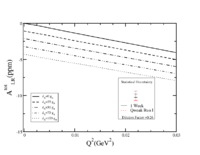
|
| The expected statistical uncertainty for a measurement of $d_{\Delta}$ using the current data set from the last Qweak run and assuming a full week of beam time. |
Results from prior NSF Support
PrimEx I/II
\subsection{Results from Prior NSF Support}
\subsubsection{PrimEx I}
Substantial progress has been made in the PrimEx project during the preceding funding period. First, analysis of the PrimEx I run was completed and the resulting radiative decay width, $\Gamma(\pi^o\rightarrow\gamma\gamma) = 7.82\pm0.14 (stat)\pm0.17(syst.)$ was published in Physical Review Letters~\cite{primexIresult}. Figures \ref{minv_elast} and \ref{ang_dist} show elasticity, pion invariant mass, and angular distributions obtained in PrimEx~I as an indication of the quality of the data obtained.
\singlespace \begin{figure} \centering \includegraphics[height=3in]{figs/minv_elast.eps} \caption{Typical distributions of reconstructed elasticity (left) and $m_{\gamma\gamma}$ (right) for one angular bin.} \label{minv_elast} \end{figure} \doublespace
\singlespace \begin{figure} \begin{center} { \scalebox{0.5} [0.5]{\includegraphics[height=4.5in]{figs/primex1_ang_dist.eps}} \scalebox{0.5} [0.5]{\includegraphics[height=4.5in]{figs/dsdt_lead_partial.eps}} } %\includegraphics[height=3.0in]{figs/primex1_ang_dist.eps} \caption{Differential cross section as a function of $\pi^o$ production angle together with fit results for the different physics processes. Left and right plots are for $^{12}C$ and $^{208}Pb$ targets respectively.} \label{ang_dist} \end{center} \end{figure} \doublespace
Second, a draft of a paper describing the techniques by which the PrimEx Collaboration attained a $1\%$ uncertainty in the luminosity has been prepared by a CoPI (D.~Dale) and is presently circulating in the Collaboration. In 1990, Owens published a paper describing the techniques for analyzing tagged photon experiments~\cite{Owens1990}. Building on this work, the PrimEx Collaboration has developed a number of new techniques for luminosity monitoring including the implementation of multi-hit TDCs, electron counting via a sampling method involving clock triggers, and online beam diagnosis with a pair production spectrometer. We expect to submit this paper to NIM in the next couple of months.
\subsection{PrimEx II}
During the Fall of 2010, the PrimEx Collaboration had their second data taking run. In this run, there were several improvements to the experimental setup as compared to PrimEx~I. These included some modifications to the beamline, individual TDCs on the inner modules of the HYCAL pion calorimeter, and increased charged particle veto channels on the pion detector. High quality data were taken on both carbon and silicon targets where approximately 8000 and 20,000 pions were obtained in the two targets, respectively. An example of a preliminary pion angular distribution for the silicon target is shown in Fig.~\ref{figsi}.
\singlespace \begin{figure} \centering \includegraphics[height=2.75in]{figs/silconangulardist.eps} \caption{Preliminary angular distribution as a function of $\pi^o$ production angle for the silicon target in the PrimEx~II run.} \label{figsi} \end{figure} \doublespace
\subsubsection{Graduate Student Analysis Results}
\medskip \begin{center} \underline{\sf Vector Meson Photoproduction} \end{center}
The probe afforded by a beam of linearly-polarized photons allows one to gain access to several observables in photonucleon reactions, which otherwise would not be measurable. The polarization axis defines a unique direction in space whereby the angular distributions of the final-state particles can be uniquely referenced. The polarization axis of the photon beam breaks the azimuthal symmetry of the reaction, thereby introducing an azimuthal ($\varphi$) dependence to the differential cross section. This additional information on the angular dependence opens the door to the measurement of a host of observables, which are accessible only with a beam of linearly-polarized photons; consequently it provides important constraints on the nature of the photon-nucleon reaction. Such polarization observables are necessary for extracting the spin/parity of the broadly overlapping baryon resonances and measuring such parameters over a large energy range with full angular coverage is crucial for disentangling such contributions.
The scientific purpose of g8~\cite{Cole94,Ted98,FKlein99,Sanabria01,Pasyukg8,g8papers} seeks to improve the understanding of the underlying symmetry of the quark degrees of freedom in the nucleon, the nature of the parity exchange between the incident photon and the target nucleon, and the mechanism of associated strangeness production in electromagnetic reactions. With the high-quality beam of the tagged and collimated linearly-polarized photons afforded by the Coherent Bremsstrahlung Facility (CBF) and the nearly complete angular coverage of the Hall~B spectrometer, we seek to extract the differential cross sections and polarization observables for the photoproduction of vector mesons and kaons at photon energies ranging between 1.10 and 2.20~GeV.
The first phase of the g8 run marked the commissioning of the CBF. It took place in the summer of 2001 (6/04/01 - 8/13/01) in Hall~B of Jefferson Lab and provided the Ph.D.~thesis work for two students~\cite{CGordon, JMelone} and the material for two master's theses~\cite{APuga, JSalamanca}); g8b followed four years later culminating in four PhD theses~\cite{Paterson-g8b, Collins-g8b, Salamanca-g8b, Hanretty-g8b} and one is on the way~\cite{Martinez-g8b}.
These experiments made use of a beam of linearly-polarized photons produced through coherent bremsstrahlung and marked the first time such a probe was employed at Jefferson Lab. The g8 set of experiments, therefore, was a vital first step in establishing the CBF and this experience paved the way for several subsequent successful runs with linearly polarized photons in Hall~B of JLab: g13b ($\vec{\gamma}d$), and g9a/b ($\vec{\gamma}\vec{p}$). At the time of this writing, HDIce (g14) is poised to run; HDIce is a search for N*s using polarized photons directed onto a separably-polarizable proton and deuteron target and will be closing experiment for CLAS6. The lessons learned in calibration and cooking for the earlier g8 experiments have accelerated the analyses for the g13a/b, g9a, and presumably g14. Currently three students at ISU are playing key roles in calibrating detectors for g13 and will continue to give such assistance with g14. Danny Mart\'{i}nez, ($\vec{\gamma}p \rightarrow \omega p$ from g8b), and Olga Cort\'{e}s ($\vec{\gamma}n (p) \rightarrow \omega n (p)$) and Charles Taylor ($\vec{\gamma}n(p) \rightarrow K^{0}_{s}\Lambda (p)$) are analyzing g13 data.
Vector meson photoproduction at high energies, as is well known, proceeds primarily through pomeron exchange rather than by $\pi$- or $\eta$-meson exchange, which are respectively termed natural- and unnatural-parity exchange. In the baryon resonance energy regime ($E_{\vec{\gamma}}\sim 2.0$ GeV) and at low four-momentum transfer squared, $t$, the peak structure of the coherent $\phi$-meson photoproduction cross section is not well explained at threshold by a pure pomeron-exchange-based model~\cite{mibe}. The extraction of the Spin Density Matrix Elements (SDMEs) from $\phi$-meson decay angular distributions will shed light on the proportion of natural and unnatural parity exchange involved in the reaction mechanism~\cite{schilling} at low $t$, which is further to be compared to the predicted values of the Vector Dominance Model (VDM)~\cite{sakurai}.
In his Ph.D.~thesis~\cite{Salamanca-g8b}, Juli\'{a}n Salamanca, extracted over 8000~$\phi$~mesons from the g8b data set at both low and high $t$ in the baryon resonance regime of $2.02 < \sqrt{s} < 2.11$ GeV. Extracting the SDMEs for the $\phi$ channel at high $|t|$ holds discovery potential for non-VDM mechanisms at higher four-momentum transfers squared. On the right hand side of Fig.~\ref{g8b-phi}, the fitted $\phi$-meson peaks are shown for two orientations of the polarization vector, $\vec{E}$. And on the left hand side are the respective angular distributions in the rest frame of the $\phi$ meson with the quantization axis pointing opposite the direction of the recoil proton, i.e.~the Helicity frame. Five SDMEs were extracted in this thesis work of Dr.~Salamanca. CLAS requires all analyses to be thoroughly reviewed by expert committee before a paper may be submitted. We have just answered the last few questions from the CLAS review committee. Once this $\phi$ analysis note is approved -- and that should be soon – we will prepare a paper for PRL or PRC on the extracted SDMEs from the photoproduction of $\phi$ mesons off protons with linearly-polarized photons.
\singlespace \begin{figure} [t] \begin{center} { \scalebox{0.5} [0.5]{\includegraphics{figs/Julian_NSF2011_1.eps}} \scalebox{0.5} [0.5]{\includegraphics{figs/Julian_NSF2011_2.eps}} } \caption{$\vec{\gamma} p \rightarrow \phi p$ and $1.7 < E_{\gamma} < 1.9$~GeV. Left side: $\phi$-meson distribution fit with a Breit-Wigner convoluted with a Gaussian peak ($\sigma \sim 11$~MeV) and a $2^{\rm nd}$-order polynomial background. Here, the direction of the polarization vector (($\vec{E}$): {\sf (a-1)} Parallel and {\sf (a-2)} Perpendicular to the floor in the CLAS lab frame. Right side: Angular distributions of the $\phi$-meson in the Helicity frame. First (second) column is for $\vec{E}_{\parallel}$ ($\vec{E}_{\perp}$. Of especial interest are the angular distributions as a function of $\cos\theta_{\rm Hel}$ showing the expected $\sin^{2}\theta_{\rm Hel}$-like behavior and the modulation as a function of azimuthal ($\phi_{\rm Hel} - \Phi$) angle. Here, $\Phi$ denotes the direction of $\vec{E}$.} \label{g8b-phi} \end{center} \end{figure} \doublespace
\singlespace \begin{figure} [!hbp] \begin{center} { \scalebox{0.5} [0.5]{\includegraphics{figs/Omega-danny.eps}} } \caption{$\vec{\gamma} p \rightarrow \omega p$ and $\omega \rightarrow \pi^+ \pi^- \pi^0$. Plotted are the beam asymmetry parameters, $\Sigma$, for the three separate photon energies: {\sf (a)} $1.81 < E_{\vec{\gamma}} < 1.83$~GeV, {\sf (b)} $1.83 < E_{\vec{\gamma}} < 1.85$~GeV, and {\sf (c)}~$1.85 < E_{\vec{\gamma}} < 1.87$~GeV. For each $\cos\theta_{\rm cm}$ bin, there are 18 $\phi$ bins from which $\Sigma$ is extracted. The solid squares correspond to the $\phi$ bin, method from ISU and the closed correspond to method of moments from a separate analysis~\cite{Collins-g8b,dugger}. (d) $\omega$ meson signal: Voigtian (Breit Wigner + Gaussian) with a $4^{\rm th}$-degree polynomial for the background.} \label{g8b-omega} \end{center} \end{figure} \doublespace
The analysis of the photoproduction of $\omega$ mesons off hydrogen is an absolute must before this channel may be analyzed from neutrons in deuterium. Danny Mart\'{i}nez has made significant progress in extracting the photon beam asymmetry parameter $\Sigma$ by fitting the correctly normalized ratio of the yields $\frac{N_{\perp} - N_{\parallel}}{N_{\perp} + N_{\parallel}}$ to a $\cos{2\phi}$-like function for each $\cos{\theta}$ bin and $E_{\gamma}$ bin (see Fig.~\ref{g8b-omega}). This $\phi$-bin method compares well with the results from the method of moments~\cite{Collins-g8b,dugger}. The extracted $\Sigma$ will constrain combinations of the SDMEs. Further, this analysis on the proton will be the starting point for the photoproduction of omega mesons off neutrons, which will form the Ph.D.~thesis work for Ms.~Cort\'{e}s.
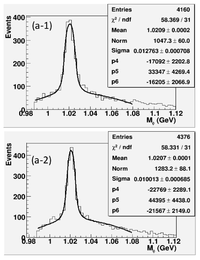 |
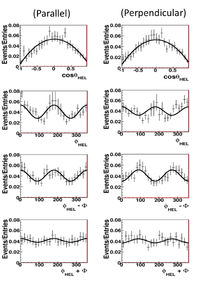 |
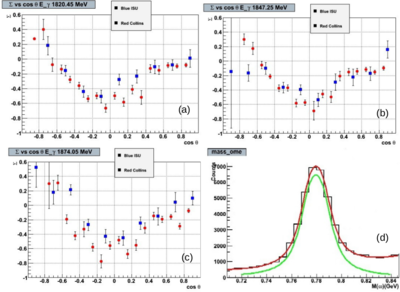
|
\medskip \begin{center} %\underline{\sf Tamuna's Exclusive Pion Production Comparison with Joo's et.~al.~ Publication} \underline{\sf Exclusive Pion Production} \end{center}
\singlespace \begin{figure} [!hbp] \begin{center} { \scalebox{0.5} [0.5]{\includegraphics[height=3.0in]{figs/Kinematics_single_pion_electroproduction_1.eps}} \scalebox{0.5} [0.5]{\includegraphics[height=4.0in]{figs/Phi_angle_in_CM_Frame_vs_Relative_Rate_cos_theta_0-4_0-6_W_1-45.eps}} } \caption{Left: An illustration of the kinematic quantities used to describe exclusive single pion production. Right: A comparison of the inclusive pion production measured using and $NH_3$ target to the published results from CLAS experiment E99-107 which used a liquid hydrogen target.} \label{TamunExcusivePionFig} \end{center} \end{figure} \doublespace
Figure~\ref{TamunExcusivePionFig} shows a comparison of the relative exclusive pion production ($\vec{e} p \rightarrow en\pi^+$) rates measured using a liquid hydrogen target in E99-107 to the measurements using a polarized ammonia ($NH_3$) target. The comparison was done as part of T. Didberidze's SIDIS analysis for the purpose of cross checking pion identification methods used in CLAS. The kinematics of single pion electroproduction can be described by five variables: the virtual photon negative four-momentum transferred squared $Q^2$, $W$ invariant mass of the photon-nucleon system, $\theta_{\pi}^*$ the polar and $\phi_{\pi}^*$ the azimuthal angle of the outgoing pion in center of mass frame and $\phi_e$ the scattered electron azimuthal angle. The five-fold differential cross section can be written in the following way for a single pion electroproduction:
\begin{equation} \frac{\partial^5 \sigma}{\partial E_f \partial \Omega_e \partial {\Omega_{\pi}}^*} = \frac{1}{2 \pi} \Sigma \frac{1}{L_{int} A_{cc} \epsilon_{CC} \Delta W \Delta Q^2 \Delta cos {\theta_{\pi}}^{\!*} \Delta {\phi_{\pi}}^{\!*}} \frac{d(W, Q^2)}{d(E_f, cos \theta_e)} \end{equation}
where $L_{int}$ represents the integrated luminosity, $A_{cc}$ is the acceptance factor, $\epsilon_{CC}$ represents the efficiency of the Cerenkov detector and the Jacobian term can be expressed in terms of the initial and final energy of lepton:
\begin{equation} \frac{d(W, Q^2)}{d(E_f, cos \theta_e)} = \frac{2 M_p E_i E_f}{W} \end{equation}
The E99-107 measurement shown in Fig.~\ref{TamunExcusivePionFig} used the following kinematic cuts; $0.9 < M_x < 1.1$, invariant mass $1.44 < W < 1.46$ and $0.4 < cos\theta_{\pi}^{CM} < 0.6$. Despite the low statistics available for the kinematic region shared by both experiments, the rate dependence on $\phi_{\pi}^*$ that is reproduced using the NH3 target is an excellent cross check that increases confidence in the standard methods used by CLAS to identify the $\pi^+$.
- Reference
- Park, K., Burkert, V. D., & Kim, W. (The CLAS Collaboration). (2008). Cross sections and beam asymmetries for \vec{e} p->en\pi^+ in the nucleon resonance region for 1.7 < Q^2 < 4.5 (GeV)^2. Phys. Rev., C77, 015208.
Future Use of NSF Funds
Work Plan
\subsection{Future Use of NSF Funds}
\medskip \begin{center} \underline{\sf Work Plan} \end{center}
A timeline for the work undertaken to satisfy the objectives for the funding cycle of this proposal is shown in Table~\ref{table:Timeline}. The drift chamber construction for Hall~B is a critical component in support of the 12 GeV upgrade program at JLab and will support the ISU physics program. The Region~I tracking system is expected to be delivered to JLab during the summer of 2013. Graduate students will continue analyzing the g13 and g8 data sets for their Ph.D.~thesis. At least one Ph.D.~student will graduate during the proposed funding cycle. The group is looking to carve out a physics program beyond the 12~GeV program at JLab that can be directly associate with ISU. Two members of the group are involved in a JLab sponsored project to develop a polarized positron source for JLab. The development of a research program using a polarized positron source for experiments in Hall~B would be a natural direction to proceed and is currently under consideration. Less than 5\% of the group's workload would be spent investigating the physics opportunities of polarized positron beams.
\begin{table}[h]
\caption{Work Plan Timeline}
\begin{center}
\begin{tabular}{ll}
\multicolumn{1}{r}{Date}& \multicolumn{1}{c}{Objective}\\
\hline\hline 3/12 & Complete stringing and testing R1 Drift chamber \#2\\
8/12 & Complete stringing and testing R1 Drift chamber \#3\\
9/12 & Complete stringing and testing R1 Drift chamber \#4\\
2/13 & Complete stringing and testing R1 Drift chamber \#5\\
3/13 & Complete stringing and testing R1 Drift chamber \#6\\
5/13 & Ship drift chambers to Hall B at JLab \\
1/13 & Recommission the Beowulf cluster \\
8/15 & At least one Ph.D.~graduate \\
8/12 - 7/15 & Continue the broader impact efforts for the Americas \\
\hline
\end{tabular}
\end{center}
\label{table:Timeline} \end{table}
\medskip
\begin{center}
\underline{\sf List of Currently supported students}
\end{center}
\begin{table}[h]
\caption{Currently supported students}
\begin{center}
\begin{tabular}{lll}
\multicolumn{1}{r}{Student}&
\multicolumn{1}{c}{Major (Year of Degree)}&
\multicolumn{1}{c}{Projected}\\
\hline\hline
Tamar Didberidze & Ph.D. & 2011 \\
Danny Mart\'{i}nez & Ph.D. & 2013 \\
Charles Taylor & Ph.D. & 2013 \\
Olga Cort\'{e}s & Ph.D. & 2015 \\
\hline
\end{tabular}
\end{center}
\label{table:Students} \end{table}
| Student | Classification | Expected Grad Yr |
| Tamar Didbarize | Ph.D. | 2011 |
| Danny Mart\'{\i}nez | Ph.D. | 2013 |
| Charles Taylor | Ph.D. | 2013 |
| Olga Cort\'{e}s | Ph.D. | 2015 |
The Broader Impact of the Idaho State University Nuclear Physics Research Program
The Americas
\section{Broader Impact of the ISU Nuclear Physics Research Program} \label{section:BroaderImpacts}
\subsection{The Americas}
Our broader impacts activities are directed towards the Americas, particularly South America where we especially have good contacts. Over the past eleven years, two of the CoPIs have been active in outreach towards Latin America. CoPIs Dale and Cole can both communicate in Spanish. Speaking Spanish is necessary for our broader impacts activities. South American physics students tend to read English rather well, but speaking good English is entirely another matter. To attract students, one needs to present the many research opportunities in medium energy nuclear physics in the United States while dispelling subtle and not-so-subtle misconceptions, which unfortunately abound. And to communicate these matters effectively, one must speak Spanish at a reasonable level. We seek to promote dialog between faculty members of North-American and Latin-American institutions by finding common interests in research which will allow for coordinating our programs in nuclear physics research. Venues such as the Latin American Symposia on Nuclear Physics and Applications, which convene every two years in alternating countries in Latin America, offer great opportunities for strengthen existing links and forging new ones within the broad scope of the international nuclear physics community. Members of our group have attended every one of these biennial symposia since 1999. CoPI Cole has been an editor twice on these proceedings and is on the standing organizational executive committee. In the six years that the ISU Physics Department has had a Ph.D.~program, we have attracted four talented students from Colombia to Pocatello, Idaho. We are closing the loop and, in the process, we are strengthening our ties to Colombia. Dr.~Salamanca graduated in December, 2009, our first Ph.D.~in JLab physics at ISU. He recently became an Assistant Professor at Universidad Distrital in Bogot\'{a}, Colombia. We can only expect to draw more students to the ISU graduate physics program from this excellent connection.
\subsection{Graduate Student Training and Marketability}
The role graduate students play in the experiments which take place within our program provide them with marketable skills. In the past three years, the ISU group has graduate a Ph.D.~student and a Masters student. As mentioned in the previous section, Juli\'{a}n Salamanca graduated from ISU's program with a Ph.D.~thesis based on the CLAS and is now an Assistant Professor at Universidad Distrital in Bogot\'{a}, Colombia. Another student, Warren Parsons, graduated from ISU with a masters degree and is now employed in the technology sector. Both graduates have stated that the construction projects undertaken using the facilities at ISU were instrumental to their success after graduation. These two examples are not unique but rather representative of the well-rounded education students receive when doing research which combines projects at ISU and Jefferson Lab. We intend to continue using this bridge as a means to train students with marketable skills that increase their chances for success after graduation.
References Cited
\begin{thebibliography}{5} %1 \bibitem{RothNIM} Stephan A. Roth and Reinhard A. Schumacher, Nuclear Instruments and Methods in Physics Research A 369 (1996) 215-221 %2 \bibitem{Zheng} X. Zheng {\it et al.}, Phys.~Rev.~Lett.`{\bf 92} 012004 (2004) %3 \bibitem{AirapetianHERMES} A. Airapetian {\it et al.} Phys.~Rev.~{\bf D71} 012003 (2005) %4 \bibitem{Nstar-12GeV} {\it Nucleon Resonance Studies with CLAS12}, Jefferson Lab E12-09-003, V.D.~Burkert, P.L.~Cole, R.W.~Gothe, K.~Joo, V.I.~Mokeev, and P.~Stoler, cospokespersons. %5 \bibitem{Az09} I.G.~Aznauryan, V.D.~Burkert {\it et al.} (CLAS Collaboration), Phys.~Rev.~{\bf C80}, 055203 (2009). %6 \bibitem{Mo09} V.I.~Mokeev, V.D.~Burkert {\it et al.}, arXiv:0906.4081 %7 \bibitem{Wp09} Theory Support for the Excited Baryon Program at the Jlab 12 GeV Upgrade, JLAB-PHY-09-993, arXiv:0907.1901[nucl-th], [nucl-ex], [hep-lat]. %8 \bibitem{Gia08} E.~De Sanctis {\it et al.}, Phys.~Rev.~{\bf C76}, 062201 (2007). %9 \bibitem{Suz10} N.~Suzuki, T.~Sato, and T.-S.H.~Lee, Phys.~Rev.~{\bf C82} 045206 (2010). %10 \bibitem{Bh03} M.S.~Bhagwat {\it et al.}, Phys.~Rev.~{\bf C68}, 015203 (2003). %11 \bibitem{Bh06} M.S.~Bhagwat and P.C.Tandy, AIP Conf.~Proc.~{\bf 842}, 225 (2006). %12 \bibitem{Bow} P.O.~Bowman {\it et al.}, Phys.~Rev.~{\bf D71}, 015203 (2005). %13 \bibitem{book} See {\sl e.g.} Dynamics of the Standard Model, J.F. Donoghue, E. Golowich, and B.R. Holstein, Cambridge University Press (1992). %14 \bibitem{PDB} R.M. Barnett {\it et al.}, Review of Particle Physics, Phys. Rev. D {\bf 54},1 (1996). %15 \bibitem{Goity} J. L. Goity, A. M. Bernstein, J. F. Donoghue, and B. R. Holstein, manuscript in preparation; J. L. Goity, talk at Baryons 2002. %16 \bibitem{Ioffe07} B.L. Ioffe and A.G. Oganesian, Phys. Lett.~B {\bf 647}, 389 (2007). %17 \bibitem{Erler} J.~Erler and M.~J.~Ramsey-Musolf, arXiv:hep-ph/0409169; hep-ph/0005084. %18 \bibitem{Qweak} Q$_{weak}$ Experiment, JLab Experiment E05-008, R. Carlini spokesperson (www.jlab.org/Qweak). %19 \bibitem{LOIdDelta} Letter of Intent (LOI-03-105) to JLab PAC24. %20 \bibitem{Zhu012} Shi-Lin Zhu, C.M. Mackawa, G. Sacco, B.R. Holstein, and M.J. Ramsey-Musolf, Phys. Rev. D {\bf 65}, 033001 (2002). %21 \bibitem{primexIresult} I. Larin, D. McNulty {\it et al.}, A New Measurement of the $\pi^0$ Radiative Decay Width Phys. Rev. Lett. 106:162303, 2011 5pp. %22 \bibitem{Owens1990} R.O. Owens, Nucl. Instr. and Meth. A288 (1990) 574. %23 \bibitem{Cole94} {\it Photoproduction of $\rho$ Mesons from the Proton with Linearly Polarized Photons}, Jefferson Lab E-94-109, P.L.~Cole and K.~Livingston, co-spokespersons. %24 \bibitem{Ted98} {\it Photoproduction of $\phi$ Mesons with Linearly Polarized Photons, Jefferson Lab} E-98-109, D.J.~Tedeschi, P.L.~Cole, and J.A.~Mueller, co-spokespersons. %25 \bibitem{FKlein99} {\it Photoproduction of $\omega$ Mesons off Protons with Linearly Polarized Photons}, Jefferson Lab \mbox{E-99-013}, F.J.~Klein and P.L.~Cole, co-spokespersons. %26 \bibitem{Sanabria01} {\it Photoproduction of Associated Strangeness using a Linearly Polarized Beam of Photons}, CLAS Approved Analysis 2001, J.C.~Sanabria, J.~Kellie, and F.J.~Klein, co-spokespersons. %27 \bibitem{Pasyukg8} {\it Proposal for CLAS Approved Analysis (CAA) for Beam Asymmetry in $\eta^{\prime}$, $\pi^{\circ}p$, and $\pi^{+}n$ Photoproduction with g8b Data}, P.~Collins J.~Ball, M.~Dugger, E.~Pasyuk, B.G.~Ritchie, W.J.~Briscoe, I.I.~Strakovsky, and R.L.~Workman. Oct.~27, 2006. %28 \bibitem{g8papers} See: \underline{\sf http://www.jlab.org/exp\_prog/generated/apphallb.html} to view the above approved proposals in pdf and click on the experiment number (\mbox{E-94-109}, \mbox{E-98-109}, and/or \mbox{E-99-013}). These pdf files can also be found in: \underline{\sf http://www.physics.isu.edu/$\sim$cole/g8/experimental-proposals/}. %29 \bibitem{CGordon} Christopher Gordon, {\it $\rho^{\circ}$ Photoproduction using Linearly Polarised Photons with the CLAS Detector}, University of Glasgow, Ph.D.~Thesis, May 2004. %30 \bibitem{JMelone} Joseph Melone, {\it Measurement of the Photon Asymmetry for the $p(\vec{\gamma}K^{+})\Lambda$ Reaction at CLAS from 1.6 to 2.0~GeV}, University of Glasgow, Ph.D.~Thesis, Dec.~2004. %31 \bibitem{APuga} Alejandro Puga, {\it Calibration of the UTEP/Orsay Instrumented Collimator via the LabVIEW-based Data Acquisition System}, University of Texas at El Paso, Master's Thesis, Dec.~2001. %32 \bibitem{JSalamanca} Juli\'{a}n Salamanca, {\it C\'{a}lculo de la aceptancia del detector CLAS para la reacci\'{o}n $\vec{\gamma} p \rightarrow K \Lambda$}, Universidad de los Andes, Bogot\'{a}, Colombia; Master's Thesis: Dec.~2004. The PI was the external committee member and attended the defense in Bogot\'{a} in November, 2004. He also used this opportunity to recruit Mr.~Salamanca to Idaho State University. %33 \bibitem{Paterson-g8b} Craig Paterson, {\it Polarization Observables in Strangeness Photoproduction with CLAS at Jefferson Lab}, Ph.D.~Thesis, University of Glasgow, June~2008. %34 \bibitem{Collins-g8b} Patrick Collins, {\it Beam Asymmetry in Eta(547) and Eta(958) Meson Photoproduction off the Proton}, Ph.D.~Thesis, Arizona State University. Aug.~2009. %35 \bibitem{Salamanca-g8b} Juli\'{a}n Salamanca, {\it $\phi$-Meson Photoproduction with Linearly Polarized Photons at Threshold Energies}, Ph.D.~Thesis, Idaho State University, Dec.~2009. %36 \bibitem{Hanretty-g8b} Charles Hanretty, {\it Measurements of the Polarization Observables I$^{\rm S}$ and I$^{\rm c}$ for $\gamma p \rightarrow p \pi^{+}\pi^{-}$ using the CLAS Spectrometer}, Ph.D.~Thesis, Dec.~2010 %37 \bibitem{Martinez-g8b} Danny Mart\'{\i}nez, {\it Photoproduction of $\omega$-Mesons with Linearly Polarized Photons}, Ph.D.~Thesis, {\it in progress}. %38 \bibitem{mibe} T.~Mibe, {\it Measurement of $\phi$-meson photoproduction near production threshold with linearly polarized~photons?, Ph.D.~thesis, Osaka University, Japan (2004), {\it unpublished}. \\ T.~Mibe {\it et al.} Phys.~Rev.~Lett.~{\bf 95}, 182001 (2005). } %39 \bibitem{schilling} K.~Schilling, P.~Seyboth, and G.~Wolf, Nucl.~Phys.~B {\bf 15}, 397 (1970). %40 \bibitem{sakurai} J.J.~Sakurai, Ann.~Phys. {\bf 11}, 1 (1960). %41 \bibitem{dugger} M.~Dugger, B.G.~Ritchie, P.~Collins, and E.A.~Pasyuk, {\it Beam asymmetry extraction technique for g8b}, CLAS-NOTE 2008-35.
Budget Justification
File:2011budgetJustification.pdf
\doublespace \Large \centerline{Budget Justification} \normalsize \medskip
The four senior personnel on this project, Dr.~Phil Cole, Dr.~Dan Dale, Dr.~Tony Forest, and Dr.~Dustin McNulty each have established physics programs at Jefferson Lab (JLab) and will continue to pursue those endeavors using the support itemized in the budget. Nearly half of the budget for this proposal is devoted to supporting several graduate students currently pursuing their Ph.D.~degrees within the JLab research program. In addition, the budget accounts for two undergraduate students to be supported by this grant. Undergraduates supported in past years have made substantial contributions to the program while gaining research experience.
To greatly assist in the productivity of the proposed Hall~B, 6 and 12~GeV, research activities, the budget provides three years of funding to support a postdoctoral researcher stationed full-time at JLab. The postdoc is intended to help pave the way for the ISU group to transition electroproduction N* studies in CLAS6 to CLAS12. For additional information, please refer to the Mentoring Plan and the Letter of Support from the Hall-B group leader, Volker Burkert. The significance of the ISU group's involvement in the present and future Hall-B physics programs justifies the need for this expense which represents 22\% of the budget.
Our annual travel budget of \$30,000 is based primarily on the several collaboration meetings we will need to attend at JLab as well as the number of shifts we expect to take. The ISU group will be assigned 16~CLAS shifts for the first half of 2012 which requires at most 4~trips to JLab when the shifts are taken in blocks of 4. Our past experiences indicate that the costs of an individual trip to JLAB from Idaho range between \$1,200 and \$2,000 per trip. We estimate that we will spend approximately \$8,000 per year in order to absorb the market fluctuations as well as the probable increases in travel costs. Each PI expects to attend at least two collaboration meetings per year. The PIs have substantial roles in the CLAS, PRIMEX, Qweak, and MOLLER collaborations. We estimate a cost of \$16,000 for this travel. We also expect to present the results of our work at conferences each year and request \$6,000 to help defray those costs.
A shipping budget for \$100 is requested to support the exchange of materials between JLab and ISU as we continue construction of the RI tracking system for CLAS12. Our Laboratory for Detector Science expends on average \$2000 in consumables each year. We expect to upgrade or replace an average of 1 computer each year which is used for data acquisition or analysis at a cost of \$1000. We will also add to our data acquisition system by purchasing NIM/VME modules at a cost of \$3000. During the first year we plan on purchasing F1 TDCs for the purpose of measuring the performance of Drift Chambers developed as part of the CLAS 12~GeV upgrade. We plan on purchasing several more channels of leading edge discriminators, gate generators, and signal amplifiers in the final two years to increase the number of detector channels we are capable of measuring with our current CODA based DAQ system.
Facilities, Equipment, and Other Resources
File:2011facilitiesEquipmentOther.pdf
\doublespace \Large \centerline{Facilities, Equipment, and Other Resources} \normalsize \medskip
The Idaho State University Department of Physics Strategic Plan identifies the use of experimental nuclear physics techniques as its focus area to addressing problems in both fundamental and applied science. The major efforts of the department include fundamental nuclear and particle physics, nuclear reactor fuel cycle physics, nuclear non-proliferation and homeland security, accelerator applications, radiation effects in materials and devices, and biology. One of the key ingredients to the department's success has been the completion of the Idaho Accelerator Center (IAC) on April 30, 1999. A substantial amount of lab space (4000 sq.~ft.) within the department has become available due to a combination of the IAC and a remodeling of the physics building. A 400 sq.~ft., class 10,000 clean room has been constructed at ISU to build the Region I drift chambers for Hall~B's 12 GeV detector upgrade.
The PIs have created a Laboratory for Detector Science at Idaho State University which houses the groups infrastructure for detector development projects. The 1200 sq.~ft. Laboratory is equipped with flow hoods, a darkroom, and a laminar flow hood used to provide a clean room environment sufficient to construct small prototype detectors. A CODA based data acquisition system with ADC, TDC, and scaler VME modules has been installed to record detector performance measurements. The PIs also established a student machine shop containing a mill, a lathe, drill press, table saw, and band which occupies its own space for the physics department to share. These facilities has a history of being used to construct detectors, measure detector prototype performance, and design electronic circuits.
The Idaho Accelerator Center (IAC) is located less than a mile away from campus and will provide a machining facility for detector construction, an electronics shop for installation of instrumentation, and beamtime for detector performance studies. The IAC houses ten operating accelerators as well as a machine and electronics shop with a permanent staff of 8 Ph.D.s and 6 engineers. Among its many accelerator systems, the Center houses a Linac capable of delivering 20~ns to 2~$\mu$s electron pulses with an instantaneous current of 80 mA up to an energy of 25 MeV at pulse rates up to 1~kHz. The IAC and JLab are currently constructing an accelerator to test a candidate positron source system for JLab. A full description of the facility is available at the web site (www.iac.isu.edu).
A Beowulf Resource for Monte-Carlo Simulations (BREMS) was built for the ISU physics department which had 60 nodes and was a 64 bit system to support the high performance computing needs of the physics research program. The HVAC system for this facility has failed and is currently being reviewed to determine the best configuration to accommodate the cluster's cooling needs. The Beowulf cluster was investment made by NSF award PHYS-987453 which we plan on maintaining. We expect to complete a review of the cooling system and deploy a solution during this NSF award.
Mentoring Plan
\doublespace \Large \centerline{Postdoctoral Researcher Mentoring Plan} \normalsize \medskip
The intermediate energy nuclear physics group at Idaho State University is requesting three years in funding to support a postdoctoral researcher. The postdoctoral researcher will be stationed at Jefferson Lab and will conduct research on excited baryons from the CLAS6 dataset, which will set the stage for future CLAS12 analyses on extracting polarization observables in the $Q^{2}$ evolution of N*s in the transition regime from constituent to asymptotically-free quarks.
The postdoctoral researcher will experience, on a daily basis, the thriving and stimulating scientific atmosphere at Jefferson Lab, and meet and work with world-class nuclear physicists. The postdoctoral researcher will frequently and regularly communicate\footnote{See: letter of support from Hall-B Leader, Volker Burkert.} with Hall-B staff physicist, Dr.~Viktor Mokeev, and the primary adviser, CoPI Cole. Through these means, the postdoctoral researcher will gain the necessary professional experience and expertise for disseminating scientific results by participating and presenting in workshops and conferences and through publishing in conference proceedings and peer-reviewed journals. The postdoctoral researcher will be strongly encouraged to lead the effort in preparing a CLAS12 experimental proposal, which involves a thorough understanding of the science and expert knowledge of how to extract the observables from the detectors. Successfully conducting independent, but coordinated, research, presenting and publishing papers, and leading a CLAS12 research effort will serve the postdoctoral researcher well towards transitioning to a faculty position. It is the goal of the ISU group for the postdoctoral researcher to ultimately become an independent Jefferson Lab collaborator.
The PI and the three CoPIs have themselves been postdoctoral researchers at Jefferson Lab and each deeply appreciates the importance of good mentoring. Besides drawing from their collective personal experiences on best practices on mentoring the postdoctoral researcher, the ISU group will adhere to the three guiding principles delineated in the work: {\it Enhancing the Postdoctoral Experience for Scientists and Engineers: A Guide for Postdoctoral Scholars, Advisers, Institutions, Funding Organizations, and Disciplinary Societies}.\footnote{Reference: National Academy of Sciences, National Academy of Engineering, Institute of Medicine. 212pp (2000), \mbox{ISBN: 978-0-309-06996-0}.} These three principles are:
\begin{enumerate} \item The postdoctoral experience is first and foremost a period of apprenticeship for the purpose of gaining scientific, technical, and professional skills that advance the professional career.
\item Postdocs should receive appropriate recognition (including lead author credit) and compensation (including health insurance and other fringe benefits) for the contributions they make to the research enterprise.
\item To ensure that postdoctoral appointments are beneficial to all concerned, all parties to the appointments -- the postdoc, the postdoc adviser, the host institution, and funding organizations -- should have a clear and mutually-agreed-upon understanding with regard to the nature and purpose of the appointment.
\end{enumerate}
Data Management Plan
File:2011dataManagementPlan.pdf
\doublespace \Large \centerline{Data Management Plan} \normalsize \medskip
\begin{enumerate}
\item{Types of Data} \\
There are various types of data collected and/or generated during the course of experimental particle and nuclear physics research. These data are nearly exclusively produced electronically by Data Acquisition (DAQ) systems and computer programs and are digitally stored on a computer hard drive. The data are initially collected from various electronic devices, e.g. ADCs, TDCs, etc. which convert an electronic signal from an experimental detector or probe into a digitally store-able format. This initial data is referred to as “raw” data and is grouped into unique computer files which share common experimental conditions. These files typically have names which include a “run”-number indicating a chronological progression of collected data. Following the data collection, the raw data is calibrated, mathematically and statistically processed, and then saved into another computer file which also includes the run-number. The processed data is then typically further refined and consolidated to produce plots and/or numerical results which convey the outcome of the experiment. The format of the raw data is typically a custom file format generated by the DAQ system control software (such as CODA or MPANT). The desired data is extracted from the raw data using an “analyzer” C++ program which also processes and/or calibrates the data and typically stores it in a ROOT file (from a standard physics analysis software application called Root).
Along with the raw and processed data files there are typically other axillary data which are organized in a data base (almost exclusively a mySQL database). The database stores various types of data including calibration constants for the detector systems, translation maps to know which DAQ electronic signal pathways correspond to which detectors, and geometrical or spacial survey information indicating where in physical space the detector systems are located. These data are typically entered into the database automatically using C++/perl programs which are developed by members of the research group.
\item{Data and Metadata Standards} \\
The format of the raw data is documented in the DAQ control software documentation which could be a large formal document available online or could be a small simple file in the data repository named “README”. The ROOT file format is more customized to the particular experiment, but typically organizes the data into histograms and/or matrices called Trees or Ntuples. The format of the ROOT files are also documented in README files or simply detailed in a traditional or electronic logbook. As a general rule, the format of the above file types are designed to be consistent for all run-numbers of a given experiment. In addition, some raw data file formats such as those produced by MPANT include a header in the data file which defines the data columns and other information such as time-stamps, etc. However, the main source of information detailing the specific conditions during the run files is maintained and stored in a logbook.
\item{Policies for Access and Sharing and Provisions for Appropriate Protection/Privacy} \\
There are no patent issues bestowing a proprietary nature to the data collected during the outlined research projects, therefore, there are no restrictions to its access. The data will be freely available to other groups internal to Jefferson Lab (JLab) by simply accessing the data repository; to groups outside JLab, the data may be made freely available by verbal or written request. As with most fundamental physics research, groups outside the experiment collaboration may not publish any results without the permission of said collaboration. There are no ethical or privacy issues with any of the data.
\item{Policies and Provisions for Re-Use, Re-Distribution} \\
Since there are no patent issues which restrict access to the data, the data will be made freely available to all with no restrictions or provisions for re-use or re-distribution.
\item{Plans for Archiving and Preservation of Access} \\
The long term strategy for maintaining, curating and archiving the processed data is to store it on a UNIX computer system with a RAID 1 disk storage system which is regularly backed-up to an additional RAID 1 disk on a central server system maintained by the ISU physics department computer administrator. In addition, all raw data, processed root file data, database data, software codes and scripts, and webpage source code will be stored in a robotic tape mass storage system at JLab and will be preserved for a period not less than 20 years after the data was collected. There are no major transformations that are necessary for preparing the data for preservation or for sharing the data. However, any documentation that is not in electronic form will be scanned into a pdf document and stored alongside the data.
\end{enumerate}
